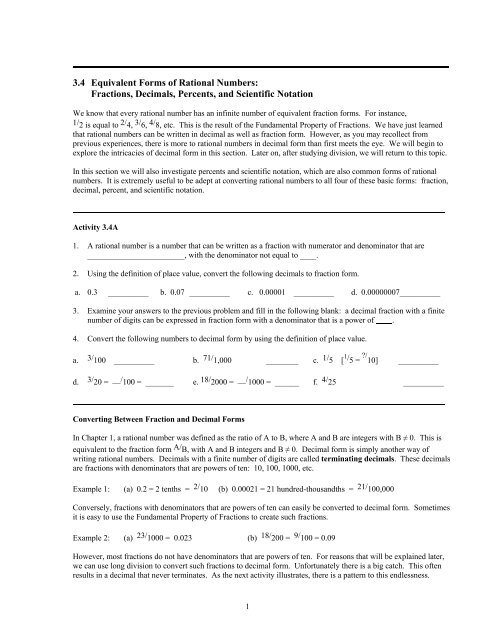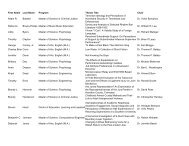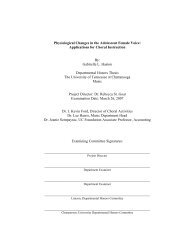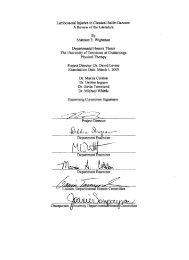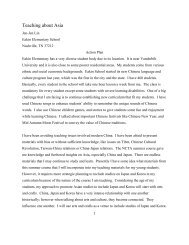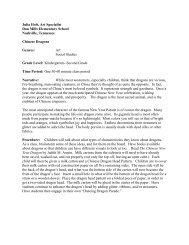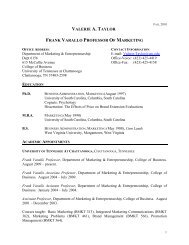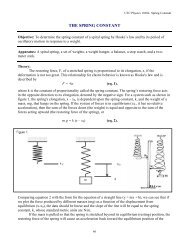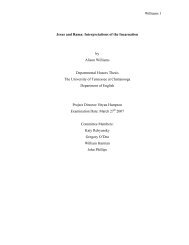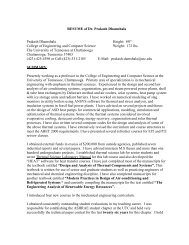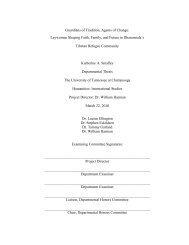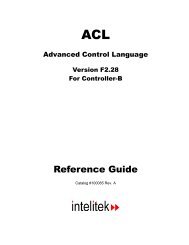3.4 Equivalent Forms of Rational Numbers: Fractions, Decimals ...
3.4 Equivalent Forms of Rational Numbers: Fractions, Decimals ...
3.4 Equivalent Forms of Rational Numbers: Fractions, Decimals ...
You also want an ePaper? Increase the reach of your titles
YUMPU automatically turns print PDFs into web optimized ePapers that Google loves.
_____________________________________________________________________________________________<br />
<strong>3.4</strong> <strong>Equivalent</strong> <strong>Forms</strong> <strong>of</strong> <strong>Rational</strong> <strong>Numbers</strong>:<br />
<strong>Fractions</strong>, <strong>Decimals</strong>, Percents, and Scientific Notation<br />
We know that every rational number has an infinite number <strong>of</strong> equivalent fraction forms. For instance,<br />
1/ 2 is equal to 2/ 4, 3/ 6, 4/ 8, etc. This is the result <strong>of</strong> the Fundamental Property <strong>of</strong> <strong>Fractions</strong>. We have just learned<br />
that rational numbers can be written in decimal as well as fraction form. However, as you may recollect from<br />
previous experiences, there is more to rational numbers in decimal form than first meets the eye. We will begin to<br />
explore the intricacies <strong>of</strong> decimal form in this section. Later on, after studying division, we will return to this topic.<br />
In this section we will also investigate percents and scientific notation, which are also common forms <strong>of</strong> rational<br />
numbers. It is extremely useful to be adept at converting rational numbers to all four <strong>of</strong> these basic forms: fraction,<br />
decimal, percent, and scientific notation.<br />
____________________________________________________________________________________________<br />
Activity <strong>3.4</strong>A<br />
1. A rational number is a number that can be written as a fraction with numerator and denominator that are<br />
________________________, with the denominator not equal to ____.<br />
2. Using the definition <strong>of</strong> place value, convert the following decimals to fraction form.<br />
a. 0.3 __________ b. 0.07 __________ c. 0.00001 __________ d. 0.00000007__________<br />
3. Examine your answers to the previous problem and fill in the following blank: a decimal fraction with a finite<br />
number <strong>of</strong> digits can be expressed in fraction form with a denominator that is a power <strong>of</strong> .<br />
4. Convert the following numbers to decimal form by using the definition <strong>of</strong> place value.<br />
a. 3/ 100 __________ b. 71/ 1,000 ________ c. 1/ 5 [ 1 / 5 = ?/ 10] __________<br />
d. 3/ 20 = __/ 100 = _______ e. 18/ 2000 = __/ 1000 = ______ f. 4/ 25 __________<br />
____________________________________________________________________________________________<br />
Converting Between Fraction and Decimal <strong>Forms</strong><br />
In Chapter 1, a rational number was defined as the ratio <strong>of</strong> A to B, where A and B are integers with B ≠ 0. This is<br />
equivalent to the fraction form A/ B, with A and B integers and B ≠ 0. Decimal form is simply another way <strong>of</strong><br />
writing rational numbers. <strong>Decimals</strong> with a finite number <strong>of</strong> digits are called terminating decimals. These decimals<br />
are fractions with denominators that are powers <strong>of</strong> ten: 10, 100, 1000, etc.<br />
Example 1: (a) 0.2 = 2 tenths = 2/ 10 (b) 0.00021 = 21 hundred-thousandths = 21/ 100,000<br />
Conversely, fractions with denominators that are powers <strong>of</strong> ten can easily be converted to decimal form. Sometimes<br />
it is easy to use the Fundamental Property <strong>of</strong> <strong>Fractions</strong> to create such fractions.<br />
Example 2: (a) 23/ 1000 = 0.023 (b) 18/ 200 = 9/ 100 = 0.09<br />
However, most fractions do not have denominators that are powers <strong>of</strong> ten. For reasons that will be explained later,<br />
we can use long division to convert such fractions to decimal form. Unfortunately there is a big catch. This <strong>of</strong>ten<br />
results in a decimal that never terminates. As the next activity illustrates, there is a pattern to this endlessness.<br />
1
____________________________________________________________________________________________<br />
Activity <strong>3.4</strong>B<br />
1. Use long division on separate paper to convert the following fractions to decimal form. Do not round your<br />
answers.<br />
a. 1/ 9 _____________ b. 3/ 7 _____________ c. 5/ 12 _____________ d. 5/ 270 _____________<br />
2. What happens eventually in each <strong>of</strong> the decimal forms <strong>of</strong> these rational numbers?<br />
____________________________________________________________________________________________<br />
For reasons that we will investigate later, the decimal form <strong>of</strong> a rational number either terminates or contains a block<br />
<strong>of</strong> digits that repeat forever. The repetitions are indicated either by an ellipsis (…) or a bar over the repeating digits.<br />
Be careful to draw this bar only over the digits that repeat. In a later chapter, we will investigate how to change a<br />
repeating decimal to fraction form.<br />
Example 3: (a) 1/ 40 = 1 ÷ 40 = 0.025<br />
(b) 5/ 12 = 5 ÷ 12 = 0.416666... = 0.416<br />
(c) 2/ 7 = 2 ÷ 7 = 0.28571428571428 ... = 0.285714<br />
A Warning about Calculators<br />
<strong>Rational</strong> numbers written in decimal form either terminate or repeat.<br />
<strong>Numbers</strong> reported on a calculator are restricted by the finite number <strong>of</strong> display spaces on the screen. Thus using a<br />
calculator to convert a number from fraction to decimal form <strong>of</strong>ten leads to an approximation. Most calculators<br />
round the last digit on display using the rule <strong>of</strong> thumb for five: if the next digit is 5 or above, the last digit on<br />
display is rounded up. Thus the calculator will display 0.4166666667 for 5/ 12. The exact answer is 0.4166….<br />
A Special Unit: Percent<br />
“Hundredths” is a very useful unit, especially in situations involving small parts. For instance, bankers will lend you<br />
money if you pay them interest to the tune <strong>of</strong>, say, 16 hundredths <strong>of</strong> what you wish to borrow. It is common to refer<br />
to hundredths or per hundred as “per cent.” “Cent” is short for a Latin word referring to 100. (“Cent” is a root for<br />
many other words referring to 100, such as century, centennial, and centipede.) Because it is so common to refer to<br />
“per cents,” people developed the % sign to mean per hundred. Any rational number can be written in percent form,<br />
with hundredths as the unit. In practice, percents are usually used only for smaller rational numbers in situations<br />
involving ratios. Later we will investigate percents in such contexts. For now, we merely consider the basic<br />
meaning <strong>of</strong> a percent as an alternate form <strong>of</strong> a rational number.<br />
Various Meanings <strong>of</strong> Percent<br />
We already know that 0.04, or 4 hundredths, is the same as 4 · 1/ 100. Also, multiplying by 1/ 100 is the same as<br />
dividing by 100. So “percent” is equivalent to all <strong>of</strong> the following.<br />
Percent (%) means (a) per hundred, (b) hundredths, (c) times 1/ 100, and (d) divided by 100.<br />
2
As the following activity demonstrates, these alternate meanings are useful in various situations.<br />
____________________________________________________________________________________________<br />
Activity <strong>3.4</strong>C<br />
A. Changing <strong>Forms</strong><br />
1. Percent to Decimal<br />
a. 5% = ___ hundredths, which in decimal form is ________<br />
b. 45% = 45 _________________, which in decimal form is ________<br />
c. 100% = 100 ________________, which in decimal form is ________<br />
d. 1.2% = 1.2 ________________ = 12 ___________________, which in decimal form is ________<br />
e. Examine the pattern that occurs in these problems to describe how to convert a percent to decimal form.<br />
2. Decimal to Percent<br />
a. 0.4 = 0.40 = 40 ________________ = ______% b. 0.048 = 4.8 ___________________ = _____ %<br />
c. 2 = 200 _______________________ = ______% d. 0.008 = 0.8 ___________________ = _____ %<br />
e. Use the pattern that occurs in these problems to describe how to convert a decimal to percent form.<br />
3. Fraction to Percent: Convert the following fractions to percent form, rounding to the nearest tenth <strong>of</strong> a percent.<br />
Use your calculator. [Hint: consider making a stopover at decimal form.]<br />
a. 3/ 20 _________________ b. 17/ 221 _________________ c. 459/ 3923 _________________<br />
4. Percent to Fraction: Convert the following percents to reduced fractions or whole numbers. [Hint: in some<br />
cases, it is useful to convert to decimal form first.]<br />
a. 4% _________________ b. 2.9% _________________ c. 0.01% _________________<br />
B. Untangling Mixed <strong>Forms</strong><br />
1a. In decimal form, 4 1/ 2 = _____ b. Similarly, 4 1/ 2 % = ______ % c. In decimal form, 4 1/ 2 % = ______<br />
2. Change the following to decimal form.<br />
a. 5 1/ 6% _________________ b. 5 3/ 4% _________________ c. 1/ 2% _________________<br />
3
3. “Hundredths” means “times _______”, so that the percent sign can be replaced with “times _______.”<br />
4. With this in mind, change the following percents to exact fraction form.<br />
[Hint: in multiplication, mixed numbers need to be changed to improper fractions.]<br />
a. 5 1/ 6% _________________ b. 7 2/ 3% _________________ c. 1/ 2_________________<br />
5. Try changing 7 2/ 3% to exact fraction form by converting to decimal first. What problem do you encounter?<br />
____________________________________________________________________________________________<br />
Percent ↔ Decimal<br />
It is usually easy to convert between percent and decimal forms because percent means hundredths and hundredths<br />
is a decimal place value.<br />
Example 4: (a) 8% = 8 hundredths = 0.08<br />
(b) 0.3 = 0.30 = 30 hundredths = 30%<br />
(c) 350% = 350 hundredths = 3.50 = 3.5<br />
As you can see, a simple pattern emerges. Changing from percent to decimal form is essentially changing from the<br />
hundredths unit to the ones unit. This has the visual effect <strong>of</strong> shifting the decimal point two places. But which way?<br />
Rather than simply memorizing a direction, it is wiser to understand what is happening. Since we are converting<br />
from a smaller unit (hundredths) to a larger unit (ones), the number in decimal form will be smaller than the number<br />
associated with the percent sign. Similarly, when we convert from decimal to percent form, the number associated<br />
with the percent will be larger. This is the Conversion Principle.<br />
Example 5: (a) 5% = 0.05 (b) 21 ones = 2100%<br />
5 hundredths = 0.05 ones ↓ ↓<br />
↓ ↓ smaller number larger number<br />
larger number smaller number with larger unit with smaller unit<br />
with smaller unit with large unit<br />
The resulting pattern is as follows:<br />
1. When converting from decimal to percent, move the decimal point in the direction that results in a larger<br />
number. This means that the decimal point moves two places to the right.<br />
2. When converting from percent to decimal, move the decimal point in the direction that results in a smaller<br />
number. This means that the decimal point moves two places to the left.<br />
Teaching Tip: Some people, including the author <strong>of</strong> this textbook, have great trouble remembering rules about<br />
moving left or right. Many <strong>of</strong> these people, including future students <strong>of</strong> yours, will be much happier if they are<br />
taught the Conversion Principle and develop an understanding about the sizes <strong>of</strong> numbers, rather than trying to<br />
memorize a meaningless rule.<br />
Percent ↔ Fraction<br />
Since percent means hundredths, it is easy to change simple percents to fraction form.<br />
Example 6: 45% = 45 hundredths = 45/ 100 = 9/ 20<br />
4
If a percent contains a decimal, it is usually easier to convert to decimal form first, then to fraction form.<br />
Example 7: 4.9% = 0.049 = 49/ 1000<br />
If a percent contains a fraction, it is sometimes possible to change completely to fraction form by converting to<br />
decimal form first.<br />
Example 8: 5 1/ 4% = 5.25% = 0.0525 = 525/ 10,000 = 21/ 400<br />
However, if the decimal form is non- terminating, use the fact that “hundredths“ means to multiply by 1/ 100.<br />
Example 9: 4 1/ 3% = 4 1/ 3 • 1/ 100 = 13/ 3 • 1/ 100 = 13/ 300<br />
Being able to perform these conversions is an essential skill. Some <strong>of</strong> these conversions are very simple, while<br />
some are more involved. All should be mastered thoroughly.<br />
Common Equivalences<br />
Number sense is greatly enhanced by knowing certain basic equivalences among fraction, decimal, and percent<br />
forms, including the following.<br />
Common Equivalences<br />
Halves, Fourths, and Eighths Thirds and Sixths Wholes<br />
_____________________________________________________________________________________________<br />
1/ 8 1/ 4 1/ 2 5/ 8 3/ 4 7/ 8 1/ 6 1/ 3 2/ 3 5/ 6 1 2<br />
_____________________________________________________________________________________________<br />
0.125 0.25 0.5 0.625 0.75 0.875 0.16 0.3 0.6 0.83 1.00 2.00<br />
_____________________________________________________________________________________________<br />
12.5% 25% 50% 62.5% 75% 87.5% 16.6% 33.3% 66.6% 83.3% 100% 200%<br />
_____________________________________________________________________________________________<br />
Fifths Tenths Hundredths Others<br />
_____________________________________________________________________________________________<br />
1/ 5 2/ 5 3/ 5 4/ 5 1/ 10 2/ 10, 3/ 10, etc. 1/ 100 2/ 100, 3/ 100, etc. 1/ 20 1/ 25<br />
_____________________________________________________________________________________________<br />
0.2 0.4 0.6 0.8 0.1 0.2, 0.3, etc 0.01 0.02, 0.03, etc. 0.05 0.04<br />
_____________________________________________________________________________________________<br />
20% 40% 60% 80% 10% 20%, 30%, etc. 1% 2%, 3%, etc. 5% 4%<br />
____________________________________________________________________________________________<br />
Scientific Notation<br />
Within the last several centuries, scientists have made a number <strong>of</strong> fascinating discoveries involving very large and<br />
very small numbers. For instance, this universe <strong>of</strong> ours is really big. Our galaxy alone is 587,800,000,000,000,000<br />
miles wide, and it is an extremely small part <strong>of</strong> the entire universe. Not only that, all matter in the universe is made<br />
up <strong>of</strong> really small atoms. A typical atom has a diameter <strong>of</strong> about 0.0000000001 meters. Pack these little guys<br />
together and they really start adding up: a cubic inch <strong>of</strong> a solid contains about 16,000,000,000,000,000,000,000,000<br />
5
atoms. It’s just mind boggling—and hard on the eyes too. Who wants to count up all those zeros? One way to get<br />
around the use <strong>of</strong> large or small numbers is to invent new units. Scientists have invented special units such as the<br />
angstrom, which is one hundred-millionth <strong>of</strong> a centimeter, and the light-year, the distance traveled by light in a year.<br />
But inventing new units is only a partial solution. The problem was solved by developing scientific notation, a<br />
special way <strong>of</strong> writing numbers using powers <strong>of</strong> ten. In this notation, a number is expressed as a product <strong>of</strong> (a) a<br />
value between one and ten and (b) a power <strong>of</strong> 10. To understand how this notation works, first recall that<br />
multiplying by 10 N , with N a nonnegative integer, makes the product larger and thus has the effect <strong>of</strong> moving the<br />
decimal point N places to the right.<br />
Example 10: 2.3 · 10 3 = 2300<br />
Converting a number greater than 1into scientific notation is a matter <strong>of</strong> reversing this process. Move the decimal<br />
point so that it is to the right <strong>of</strong> the first nonzero digit. The exponent for 10 corresponds to the number <strong>of</strong> places that<br />
the decimal point was moved.<br />
Example 11: (a) 4,800,000 = 4.8 · 10 6 (b) 78.4 = 7.84 · 10 1 (c) <strong>3.4</strong> = <strong>3.4</strong> · 10 0 [Remember that 10 0 = 1.]<br />
Writing small numbers between 0 and 1 in scientific notation involves the use <strong>of</strong> negative exponents. Recall that<br />
10 -N means 1/ 10 N . Multiplying by 10 -N makes the product smaller and has the visual effect <strong>of</strong> moving the decimal<br />
point N places to the left.<br />
Example 12: (a) <strong>3.4</strong> · 10 -3 = 0.0034 (b) 600.5 · 10 -2 = 6.005<br />
Thus, converting rational numbers between 0 and 1 to scientific notation is quite similar to converting larger<br />
numbers, except that the exponent <strong>of</strong> 10 is negative.<br />
Example 13: (a) 0.00409 = 4.09 · 10 -3 (b) 0.04 = 4.0 · 10 -2 (c) 400 = 4.0 · 10 2<br />
It is helpful to remember the following regarding scientific notation:<br />
(a) Positive exponents are associated with larger numbers (M ≥ 10).<br />
(b) Negative exponents are associated with smaller numbers (0 < M < 1).<br />
Teaching Tip: Sometimes conversions relative to scientific notation are taught only by referring to the left or right<br />
movement <strong>of</strong> the decimal point. Unfortunately this is quite confusing to many students. These rules are not only<br />
meaningless but hard to memorize because a positive exponent is related to both left and right movements. For<br />
instance, multiplying4 by 10 3 involves moving the decimal point three places to the right. However, converting<br />
4000 to scientific notation, 4 • 10 3 , means moving the decimal point three places to the left. An analogous situation<br />
occurs with negative exponents. It is more meaningful to connect the sign <strong>of</strong> the exponent with the size <strong>of</strong> the<br />
number: multiplying by a positive integer power <strong>of</strong> ten yields a larger product, while multiplying by a negative<br />
integer power <strong>of</strong> ten yields a smaller product.<br />
Summary <strong>of</strong> Scientific Notation<br />
Any rational number can be written as a product with the first factor having one digit<br />
to the left <strong>of</strong> the decimal point and the second factor being an integer power <strong>of</strong> 10.<br />
____ • ____ ____ ____ . . . x 10N or 10 -N or 10 0<br />
1. <strong>Numbers</strong> with absolute values greater than or equal to 10 are written with positive integer exponents.<br />
2. <strong>Numbers</strong> with absolute values between 1 and 10 are written with the 0 exponent.<br />
3. <strong>Numbers</strong> with absolute values between 0 and 1 are written with negative integer exponents.<br />
6
Calculator Notation for Scientific Notation<br />
Due to limited display space, scientific and graphing calculators have a habit <strong>of</strong> reporting very large or very small<br />
numbers in an abbreviated form <strong>of</strong> scientific notation. Following are examples <strong>of</strong> common calculator dialects.<br />
(a) 5.84 E 8 = 5.84 x 10 8 (b) 5.84 -8 = 5.84 x 10 -8<br />
____________________________________________________________________________________________<br />
<strong>3.4</strong> Homework Problems<br />
A. Answer the following. DO NOT USE A CALCULATOR.<br />
1. Write the number two tenths in the four basic forms described in this section.<br />
2. Convert the following to exact decimal form.<br />
a. 30% b. 2/ 50 c. 3.25% d. 3/ 14<br />
3. Convert the following to exact decimal form.<br />
a. 3 1/ 2% b. 5 3/ 4% c. 10 1/ 3% d. 3/ 5% e. 1 4/ 15%<br />
4. Convert the following to reduced fraction form.<br />
a. 30% b. 0.0025 c. 3.25% d. 5 1/ 4%<br />
5. Convert the following to percent form.<br />
a. 0.3 b. 0.0025 c. 3/ 40 d. 3.2<br />
e. 4/ 15 f. 5 1/ 4 g. 10 h. 0.0001<br />
6. Convert the following to scientific notation.<br />
a. 0.00045 b. 587,800,000,000,000,000 miles (diameter <strong>of</strong> the Milky Way)<br />
c. 456,000,000 d. 0.0000000001 meter (the diameter <strong>of</strong> an atom)<br />
e. 0.000406 f. 16,000,000,000,000,000,000,000,000 atoms/ cc<br />
7. Convert the following to ordinary decimal notation.<br />
a. 3.045 · 10-2 b. 3.045 · 104 c. 30 · 10-2 d. 354 · 103 e. 5.83 · 10 6 f. 5.2 · 300 g. 3.06 · 10 7 h. 0.0306 · 10 -4<br />
i. 3.06 · 10 -3<br />
j. 3.065 · 10 5<br />
k. <strong>3.4</strong>2354 E 6 l. 1.00043 -3<br />
8. Identify the types <strong>of</strong> numbers for which the exponent will be negative when the number is written in<br />
scientific notation:<br />
(a) negative numbers (b) numbers between 0 and 1<br />
(c) numbers less than 10 (d) rational numbers<br />
9. When a number is written in scientific notation, how many digits will be to the left <strong>of</strong> the<br />
decimal point?<br />
10. Convert the following to scientific notation.<br />
a. 58,000,000,000 miles b. 0.00000106 cm c. 160,000 cc d. 0.0023 kg<br />
11. Calculate without a calculator and report your answers in scientific notation:<br />
a. (8 · 10 4 ) · (5 · 10 3 ) b. (8 · 10 4 ) + (5 · 10 3 )<br />
7
c. (8 · 10 5 ) ÷ (2 · 10 3 ) d. (8 · 10 5 ) − (2 · 10 3 )<br />
12. Give four meanings <strong>of</strong> percent (%). Include a meaning involving division and a meaning involving<br />
multiplication.<br />
13. Explain why a percent can be converted to decimal form by moving the decimal point left two places and<br />
dropping the percent sign.<br />
14. Explain why 4% is the same as 4/ 100.<br />
15. A common mistake made in changing 5 3/ 4% into decimal form is to write 5 3/ 4% = 5.75.<br />
a. What is the correct decimal form <strong>of</strong> 5 3/ 4% ?<br />
b. Why do you suppose people make the above mistake?<br />
16. Explain why multiplying a decimal by 10 4 has the effect <strong>of</strong> moving the decimal point four places to the right.<br />
17. When measuring levels <strong>of</strong> pollutants in air, water, body fluids, and so on, it is common to use 1 part<br />
per million (ppm) as the unit for reporting the concentration. For instance, carbon monoxide is a very<br />
toxic gas. If the ratio <strong>of</strong> carbon monoxide to air is at levels <strong>of</strong> approximately 100-800 ppm, people will<br />
get headaches <strong>of</strong> varying severity. Levels <strong>of</strong> 1000 ppm and higher can cause dizziness, nausea,<br />
unconsciousness, brain damage and death.<br />
a. Convert 1000 ppm to decimal form.<br />
b. Convert 1000 ppm to percent form.<br />
c. Why do you suppose scientists use ppm instead <strong>of</strong> some other unit?<br />
d. Compare and contrast the two units, ppm and percent.<br />
B. An Exploration<br />
The problem is to determine what types <strong>of</strong> rational numbers have terminating decimal forms and what<br />
types have repeating decimal forms. Here are useful facts for this investigation:<br />
a. A prime number is a whole number with exactly two factors.<br />
Primes = {2, 3, 5, 7, 11, ...}.<br />
b. Non-zero whole numbers with more than two factors are called composite numbers.<br />
c. Every composite number can be written as a product <strong>of</strong> prime numbers in only one way (ignoring the order<br />
<strong>of</strong> the factors). This is called its prime factorization.<br />
1. Start a table as indicated below.<br />
Unit Fraction Prime Factorization <strong>of</strong> Denominator Decimal Form<br />
1/ 2 2 is prime. 0.5<br />
1/ 3 3 is prime. 0.33...<br />
1/ 4 4 = 2 • 2 0.25<br />
2. Complete the table for the first 20 unit fractions. Use your calculator to find the decimal forms <strong>of</strong> these<br />
fractions.<br />
3. Add another set <strong>of</strong> fractions to your list, choosing denominators between 21 and 100.<br />
4. Look for a pattern between the prime factorizations <strong>of</strong> the denominators and the decimal forms <strong>of</strong> the fractions.<br />
a. What types <strong>of</strong> rational numbers have decimal forms that terminate?<br />
b. What types <strong>of</strong> rational numbers have decimal forms that repeat?<br />
_________________________________________________________________________ ____<br />
8


